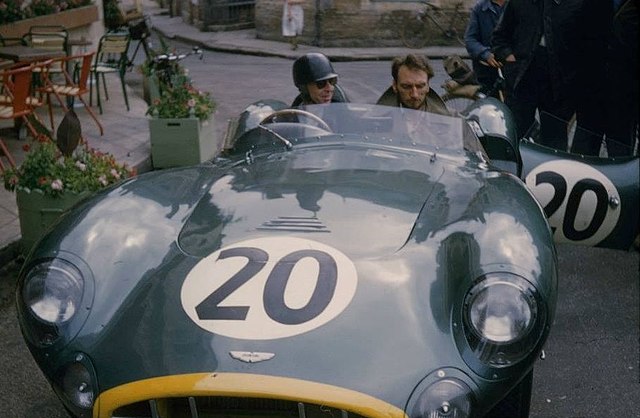The Aston Martin DB3S is a sports racing car that was built by Aston Martin. Following the failure of the heavy and uncompetitive Aston Martin DB3 designed by Eberan Eberhorst; William Watson, employed as Eberhorst's assistant, presented an alternative design to John Wyer, Aston Martin's competitions manager, whose assistance was needed as Eberhorst could well oppose being up-staged. In total 31 cars were made, with 11 works cars and 20 cars being sold for customer use.
An Aston Martin DB3S, at Goodwood Festival of Speed 2008
DB3S Coupé shown in September 2015 at the Chantilly Arts & Elegance Concours
An Aston Martin DB3S at Silverstone Classic 2007
The Aston Martin DBR1 is a sports racing car built by Aston Martin starting in 1956, intended for the World Sportscar Championship as well as non-championship sportscar races at the time. It is most famous as the victor of the 1959 24 Hours of Le Mans, Aston Martin's only outright victory at the endurance classic. It is one of only three cars in the 1950s to win both the World Sports Car Championship and Le Mans 24 Hours in the same year. In addition the six World Sports Car Championship victories was a record for any car in the 1950s and remained a record in the championship until surpassed by the Ferrari 250TR. The three consecutive triumphs in 1959 at the Nürburgring, Le Mans and the Tourist Trophy equalled the record set by the Ferrari 250TR with its three consecutive victories at the start of the 1958 season.
Aston Martin DBR1/4, next to an Aston Martin DB3S/10 at Silverstone Classic 2008
Tony Brooks with mechanic, Eric Hind parked outside the 1957 Le Mans Aston Martin base, the Hotel de France, at the wheel of his DBR1/2 race car.
DBR1/3 at Targa Florio in 1958
DBR1/1 driven by Carroll Shelby at Sebring on 22 March 1958.







